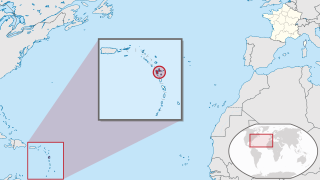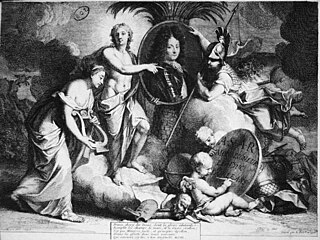External links
- Scans and transcriptions of L'Art de toucher le dessus et le basse de violle Archived 2011-07-23 at the Wayback Machine
Le Sieur Danoville (fl. late 17th century) was a French gambist and instrumental teacher.
He described himself as a disciple of Monsieur de Sainte-Colombe. In Paris in 1687, he published the book L'Art de toucher le dessus et le basse de violle about playing on viola da gamba. This concise work of 47 pages was written only for self-study. It comprises four parts, in which the attitude of the viol, the notation and the fingerboard in notation and tablature, the decorations and finally bowing are explained. Unlike Jean Rousseau's Traité de la Viole , which appeared in the same year and won extraordinary popularity, Danoville's textbook did not include an historical and aesthetic chapter, but was limited only to the technical instructions.

Guadeloupe is an archipelago and overseas department and region of France in the Caribbean. It consists of six inhabited islands—Basse-Terre, Grande-Terre, Marie-Galante, La Désirade, and the two inhabited Îles des Saintes—as well as many uninhabited islands and outcroppings. It is south of Antigua and Barbuda and Montserrat, north of the Commonwealth of Dominica. The region's capital city is Basse-Terre, located on the southern west coast of Basse-Terre Island; however, the most populous city is Les Abymes and the main centre of business is neighbouring Pointe-à-Pitre, both located on Grande-Terre Island. It had a population of 384,239 in 2019.

Marc-Antoine Charpentier was a French Baroque composer during the reign of Louis XIV. One of his most famous works is the main theme from the prelude of his Te Deum, Marche en rondeau. This theme which is still used today as a fanfare during television broadcasts of the Eurovision Network, the European Broadcasting Union.

Michel Corrette was a French composer, organist and author of musical method books.

Bruno Jean Marie Cremer was a French actor best known for portraying Jules Maigret on French television, from 1991 to 2005.
The year 1687 in music involved some significant events.
Gaspard Corrette was a French composer and organist.
Machy, known as Le Sieur de Machy was a French viol player, composer, and teacher remembered principally for his Pièces de Violle en Musique et en Tablature (1685), a valuable source of information on the performance practices of his time.

Jacques-Martin Hotteterre, also known as Jacques Martin or Jacques Hotteterre, was a French composer and flautist who was the most celebrated of a family of wind instrument makers and wind performers.
Selcë e Poshtme is a village located in the Mokra area, Korçë County, Albania. At the 2015 local government reform it became part of the municipality Pogradec. Near the village, on the right bank of Shkumbin river at an elevation of 1,040 metres (3,410 ft) above sea level, 5 Illyrian Royal Tombs of Selca e Poshtme are found. In 1996, Albania included the Royal Tombs of Lower Selcë in the UNESCO World heritage list of proposals.
The Treaty of Huế, concluded on 25 August 1883 between France and Vietnam, recognised a French protectorate over Annam and Tonkin. Dictated to the Vietnamese by the French administrator François-Jules Harmand in the wake of the French military seizure of the Thuận An forts, the treaty is often known as the 'Harmand Treaty'. Considered overly harsh in French diplomatic circles, the treaty was never ratified in France, and was replaced on 6 June 1884 with the slightly milder 'Patenôtre Treaty' or 'Treaty of Protectorate', which formed the basis for French rule in Vietnam for the next seven decades.

Jean-Baptiste Stuck was an Italian-French composer and cellist of the Baroque era.
The birth of Jesus has been depicted since early Christianity, and continues to be interpreted in modern artistic forms. Some of the artforms that have described His Nativity include drama and music.
Perrine was a French music theorist and lute teacher. He is only known by his surname. Three theoretical works by him are extant, all dealing with the practice of lute playing, which Perrine sought to revive by replacing the traditional lute tablature with staff notation:

Henri Abraham (1868–1943) was a French physicist who made important contributions to the science of radio waves. He performed some of the first measurements of the propagation velocity of radio waves, helped develop France's first triode vacuum tube, and with Eugene Bloch invented the astable multivibrator.
Joseph Michel (1679–1736) was an 18th-century French baroque chorister, composer and music teacher of the Sainte Chapelle of Dijon, demolished in 1802. A contemporary of Jean-Philippe Rameau, his reputation extended far beyond the boundaries of the city of Versailles and Burgundy.

Antoine Aimable Elie Elwart was a French composer and musicologist.
Friedrich Wilhelm Riedt was a German flautist, composer and music theorist of the Baroque period.

Elle, lui et l'autre.... is the ninth studio album by Egyptian-French vocalist Dalida. It was released in 1960. It was her second released exclusively to the Canadian public.

Gabriele Leone was an Italian musician and composer who lived in Paris during the middle and later part of the 18th century. A virtuoso on the violin and mandolin, he wrote an early mandolin method, Analytical method for mastering the violin or the mandolin in 1768 and composed for both instruments. He was an early teacher of the duo method, an advanced technique which would reappear in the 20th century, taught by Giuseppe Pettine in the United States.
Jean-Maurice Bourges, distinguished musical critic, translator and composer who came early to Paris to study composition under Auguste Barbereau. He became joint-editor for Revue et gazette musicale de Paris from 1839, which acquired an excellent reputation in great measure owing to him.